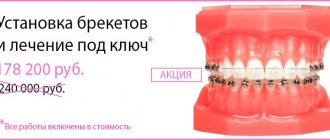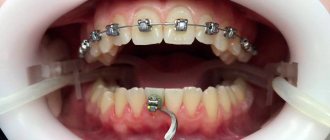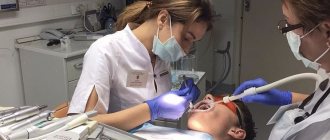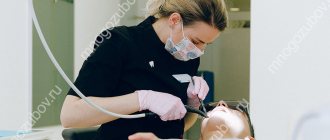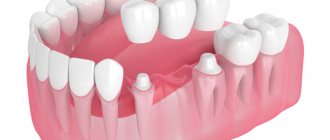To correct an abnormal bite, you can put braces on your teeth. Such orthodontic systems affect bone tissue, muscles and ligaments, and help slowly move teeth into the correct position. Many people are interested in the question: is it possible to put braces on one jaw? You will find the answer in this article.
In this article
- What are braces?
- Are braces placed on one jaw?
- Main indications for partial correction
- Orthodontic correction up to 12 years
- Braces for the lower jaw only for mild crowding
- Treatment for crowded upper anterior incisors
- Closing the gap between the front incisors
- Partial bracket system for preparation for prosthetics
- Absence of chewing teeth on the opposite jaw
- Should I install braces on one jaw or not?
What are braces?
A brace system is an orthodontic device that is installed on the teeth and helps them move in the desired direction. Structurally, this device consists of small plates (directly braces), which are glued to the dental crown at pre-calculated points, and a metal arch. This arc has shape memory and is an active element of the system. Fixed on the plates, it tries to regain its even position and thereby puts pressure on the teeth. As a result, their slow, gradual movement in the bone tissue occurs. Orthodontic treatment not only helps to correct the curvature of individual teeth in a row, it allows you to change the shape and position of the jaw, and restore facial symmetry.
It is preferable to begin orthodontic correction in childhood. But modern medical capabilities make it possible to carry it out even in adulthood and old age.
Most often, an orthodontic device is placed on two jaws at once. The dentist calculates in advance in which direction a particular tooth should move, how much it is necessary to expand the jaw or spread the dentition. Double-jaw treatment is comprehensive and allows you to solve global problems in occlusion correction. It usually takes from several months to several years.
Types of orthodontic appliances, design and materials
The design consists of the following elements - ligature, metal arches and elastic, braces made of metal or other materials. The device is used to transfer pressure to the surface of the row. This causes a restructuring of growth to give the row a normal position. The exerted force affects the movement of units in a row, allows you to correct it and eliminate growth pathologies.
The following types of constructions are used for correction:
- Vestibular orthopedic devices are attached from the outside. They are visible when worn, but provide high results. The design does not have a negative effect on the enamel if the Patient follows the care recommendations.
- Lingual systems are installed from inside the row. They are not noticeable when talking, but the cost of treatment will be higher due to more complex installation. In addition, an adjustment period is required, since at first the device may interfere.
The following materials are used for the manufacture of braces:
- metal, characterized by affordable cost, durability, reduced treatment time;
- ceramic, inconspicuous in appearance, durable, but susceptible to staining with food pigments;
- silicone based on special plastic, these are transparent structures that are distinguished by high aesthetics, but are indicated for correcting minor pathologies and slight curvature;
- sapphire transparent systems with high aesthetics, almost invisible on the enamel surface;
- combined, for example, sapphire braces are used for the upper row, and ceramic or metal-based for the lower row.
Installation Features
Fixation order:
- initial examination;
- Carrying out diagnostics, identifying problems, calculating treatment regimens;
- choice of design type;
- installation of orthodontic braces (takes about 1-1.5 hours);
- regular visits to the doctor to adjust the design;
- removal of the device;
- evaluation of the result and installation of a special structure to consolidate the result.
Price
We offer competitive rates for treatment and a free initial examination. The total cost of jaw braces depends on the following factors:
- condition of the oral cavity, the presence of diseases subject to preliminary treatment;
- performing office cleaning of plaque and stone deposits;
- prescribed diagnostic measures, consultations with related specialists;
- materials, type of construction, manufacturer;
- installation, activation of the device (calculated for each jaw separately);
- regular visits to tighten the arch and replace individual elements;
- the use of special devices after correction with braces.
About Us
Magenta Dental Clinic is a modern dental clinic offering services such as eliminating dental pathologies and restoring a beautiful, sparkling smile without pain and in the shortest possible time. Patients are provided with:
- modern methods of therapy;
- use of certified materials and equipment;
- full range of services, including diagnostics;
- control of treatment, guarantee of results;
- attentive attitude towards everyone, creation of comfortable conditions;
- affordable cost of jaw braces;
- free initial consultation with clinic doctors.
To make an appointment, leave a request on the website, indicating the coordinates for feedback. Call us at +7 (812) 242-91-90. You can also send a request for an appointment at a convenient time by email and consult with our doctors.
Are braces placed on one jaw?
Installing a brace system is one of the most common and effective methods for correcting an abnormal bite, improper closure of the teeth of the upper and lower jaw. Crooked teeth and abnormal jaw position not only spoil a person’s appearance, but also affect his health. Therefore, correcting the bite is important and necessary. But installing braces confuses many people.
Some are concerned about aesthetics, others are concerned about possible inconveniences when wearing the system, others simply want to save on orthodontic correction. And then the patient turns to the doctor with the following question: is it possible to install braces only on the upper jaw or only on the lower jaw.
As a rule, a person knows in advance which teeth he wants to change. And if they are located only on one jaw, then he expects that he will have a partial braces installed, only in the area of the curvature.
The doctor must make such a decision. It may seem to the patient that he has a problem only with the lower jaw, but the dentist sees during the examination that partial correction will not give an effective result. In this case, the orthodontist will insist on a complete correction. If you need a stable result of orthodontic treatment, we recommend listening to the professional opinion of an orthodontist.
Types of lingual braces
Today there are many varieties of internal braces from different manufacturers. The choice of devices is quite large, so everyone can find the best option. All of them effectively help eliminate crooked teeth and cope with malocclusion completely unnoticed by others, but each lingual system has its own characteristics. The devices vary depending on materials, manufacturing technology and cost. Let's look at the most popular invisible lingual braces.
STB
Bracket system from Ormco, USA. It has a round shape and is made of metal. The thickness of STB lingual braces is 1.5 millimeters, while they provide precise correction of the dentition and comfort in use. The model does not have the main disadvantage of conventional lingual appliances - large staples on the side of the tongue. STB lingual braces are quite easy to care for, so they are perfect even for children. The device has virtually no effect on pronunciation.
Incognito
An innovative German brace system made from a platinum-gold alloy is manufactured by Top Service based on an impression of the patient’s teeth: first, a 3D model of the future device is designed, taking into account the smallest nuances of the jaw structure, after which the lingual system is produced by milling using special CAD/CAM technology. Invisible lingual braces Incognito are hypoallergenic and ideal for any clinical case.
Win
Another model produced by Top Service. However, unlike Incognito lingual braces, these internal braces are miniature in size and flattened in shape. Standard Win lingual braces do not cause discomfort while wearing and are practically not felt. The system is ideally adapted to the dental surface and is suitable for eliminating pathologies of any complexity. In addition, the improved production technology of the device has made it possible to significantly reduce the cost of the model in comparison with the Incognito lingual brace system.
2D
Modern invisible braces from the German manufacturer Forestadent. They have a perfectly polished surface and a small thickness, which allows you to maintain diction and maintain wearing comfort. Also, one of the advantages of 2D lingual braces is the price, and in terms of efficiency they are not inferior to other models.
In Ovation L
Lingual metal brace system from one of the largest companies in the dental market, Dentsply. Main advantages: accessibility and versatility. The device is made from an alloy of cobalt and nickel and is sold completely ready, eliminating the need for the patient to wait. The In Ovation L system is suitable for those who will experience tooth movement of up to six millimeters.
Main indications for partial correction
In some cases, it is indeed possible to place braces on one jaw, and this approach will be effective. As a rule, these are situations where the teeth are only crooked at the top or bottom, but the bite is not broken and there is no facial asymmetry. Partial correction may be recommended for the following indications:
- one or two teeth are positioned incorrectly;
- slight crowding of teeth (lack of space - up to 3 mm);
- a gap between the front incisors in the absence of pathological closure of premolars and molars;
- correction of the position of teeth before installing dentures;
- the need to avoid sagging of the upper teeth when their antagonists (opposite units) in the lower jaw are absent.
Diagnostics will show how effective braces will be only on the upper jaw or, conversely, on the lower jaw. It should include a visual examination, x-rays, assessment of the condition of bone tissue and dental roots.
Let's consider cases when it is justified to place braces separately on the upper jaw and separately on the lower jaw.
Location of braces on implants and dentures
Adult patients often worry that they will not be able to install braces if they have a large number of fillings or crowns in their mouth. There are no contraindications in this case, but it is worth understanding that braces on artificial material may have a worse hold. As a result, the patient will need to visit the orthodontist more often than usual. This is necessary to assess the condition of the oral cavity and the tightness of the staples to the enamel surface.
The situation with implants is different. In the event that the implantation was performed 4 by 4 or 3, treatment with braces will most likely be impossible. This is explained by the fact that titanium artificial roots grow too closely with the bone tissue, so it will not be possible to displace them like ordinary roots.
Of course, one implant may not be a serious obstacle to orthodontic treatment, but all cases are considered on an individual basis. If there is a need for implantation, but the implant has not yet been installed, it is better to first correct the bite and only then implant an artificial root and install a prosthesis.
Orthodontic correction up to 12 years
Braces are primarily used for children starting in their teens. This is due to the fact that by the age of 11-12 years the formation of the jaws is completed, and the primary bite is replaced by a permanent one. But often, an orthodontist discovers bite problems in a child at an earlier age. Installing partial braces helps solve some of them, as well as prepare teeth for further correction in adolescence.
The doctor can place an orthodontic device on one jaw or individual teeth in order to:
- create space for the eruption of permanent teeth;
- expand one of the jaws;
- close the gap between the front incisors (the so-called diastema);
- correct the incorrect position of one or more teeth that are bothering the child;
- preserve the space left after early removal of baby teeth, which neighboring ones are trying to occupy.
Thus, braces can be placed on one jaw at the age of 9-10 years to solve a specific orthodontic problem. In this case, in adolescence, further, already double-jaw, treatment will be required.
BIBLIOGRAPHY
1. Sarver, D.: Interactions of hard tissues, soft tissues, and growth over time, and their impact on orthodontic diagnosis and treatment planning, Am. J. Orthod. 148:380–386, 2015. 2. Sarver, D. and Jacobson, R.S.: The aesthetic dentofacial analysis, Clin. Plast. Surg. 34:369-394, 2007. 3. Peck, H. and Peck, S.: A concept of facial esthetics, Angle Orthod. 40:284-318, 1970. 4. Schabel, BJ; McNamara, J. A. Jr.; Baccetti, T.; Franchi, L.; and Jamieson, SA: The relationship between posttreatment smile esthetics and the ABO Objective Grading System, Angle Orthod. 78:579-584, 2008. 5. Kokich, V.O.; Kiyak, A.H.; and Shapiro, PA: Comparing the perception of dentists and laypeople to altered dental esthetics, J. Esth. Dent. 11:311-324, 1999. 6. Kokich, V.O.; Kokich, V. G.; and Kiyak, H.A.: Perceptions of dental professionals and laypersons to altered dental esthetics: Asymmetric and symmetrical situations, Am. J. Orthod. 130:141- 151, 2006. 7. Auger, T. A. and Turley, P. K.: The female soft tissue profile as presented in fashion magazines during the 1900s: A photographic analysis, Int. J. Adult Orthod. Orthog. Surg. 14:7-18, 1999. 8. Schlosser, JB; Preston, C. B.; and Lampasso J.: The effects of computer-aided anteroposterior maxillary incisor movement on ratings of facial attractiveness, Am. J. Orthod. 127:17-24, 2005. 9. Desai, S.; Upadhyay, M.; and Nanda, R.: Dynamic smile analysis: Changes with age, Am. J. Orthod. 136:310.e1-310.e10, 2005. 10. Dickens, S.; Sarver, D. M.; and Proffit, W.R.: The dynamics of the maxillary incisor and the upper lip: A cross-sectional study of resting and smile hard tissue characteristics, Am. J. Orthod. 3:313-320, 2002. 11. Chetan, P.; Tandon, P.; Singh, G. K.; Nagar, A.; Prasad, V.; and Chugh, V.: Dynamics of a smile in different age groups, Angle Orthod. 83:90-96, 2013. 12. Beall, AE: Can a new smile make you look more intelligent and successful? Dent. Clin. N. Am. 51:289-297, 2007. 13. Shaw, W. C.; Rees, G.; Dawe, M.; and Charles, C.R.: The influence of dentofacial appearance on the social attractiveness of young adults, Am. J. Orthod. 87:21-26, 1985. 14. Tjan, A.H.; Miller, G.D.; and The, JG: Some esthetic factors in a smile, J. Prosth. Dent. 51:24-28, 1984. 15. Sabri, R.: The eight components of a balanced smile, J. Clin. Orthod. 39:155-167, 2005. 16. Hulsey, C.: An esthetic evaluation of lip-teeth relationships present in the smile, Am. J. Orthod. 57:132-144, 1970. 17. Ackerman, J.; Ackerman, M. B.; Brensinger, C. M.; and Landis, JR: A morphometric analysis of the posed smile, Clin. Orthod. Res. 1:2-11, 1998. 18. Pitts, T.: Bracket positioning for smile arc protection, J. Clin. Orthod. 51:142-156, 2022. 19. Proffit, W. R.; Fields, H. W.; Larson, B.; and Sarver, DM: Contemporary Orthodontics, 6th ed., Elsevier, Philadelphia, 2022, p. 160.20. Dickens, S. T.; Sarver, D. M.; and Proffit, W.R.: Changes in frontal soft tissue dimensions of the lower face by age and gender, World J. Orthod. 3:313-320, 2002. 21. Harris, E.F.; Hassankiadeh, S.; and Harris, JT: Maxillary incisor crown-root relationships in different angle malocclusions, Am. J. Orthod. 103:48-53, 1993. 22. Bryant, R. M.; Sadowsky, P.L.; Dent, M.; and Hazelrig, J.B.: Variability in three morphological features of the permanent maxillary central incisor, Am. J. Orthod. 86:25-32, 1984. 23. Van Loenen, M.; Degrieck, J.; De Pauw, G.; and Dermaut, L.: Anterior tooth morphology and its effect on torque, Eur. J. Orthod. 27:258–262, 2005. 24. Mavroskoufis, F. and Ritchie, G. M.: Variation in size and shape between left and right maxillary central incisor teeth, J. Prosth. Dent. 43:254-257, 1980. 25. Chaushu, S.; Sharabi, S.; and Becker, A.: Tooth size in dentitions with buccal canine ectopia, Eur. J. Orthod. 25:485-491, 2003. 26. Balut, N.; Klapper, L.; Sandrik, J.; and Bowman, D.: Variations in bracket placement in the preadjusted orthodontic appliance, Am. J. Orthod. 102:62-67, 1992.
Braces for the lower jaw only for mild crowding
Crowding is the position of teeth when they are too close to each other. As a result, rotation, curvature, and “layering” of each other occur. If slight crowding is observed only on the lower front incisors, while the upper front incisors are positioned evenly and the lateral ones close correctly, in this case, braces are sometimes placed only on the lower jaw. An important condition for this method is that there must be enough space to move horizontally so that the teeth can take the correct position. This treatment method is chosen in cases where the lack of space for alignment is less than 3 mm. With this method, separation of the front incisors is almost always performed - that is, minor grinding of the contact surfaces, which allows you to free 0.25 mm from each surface and in total create those missing 1-3 mm for alignment in the dentition.
Features of choosing a brace system for the lower jaw
Since the upper teeth are more visible when talking and smiling, this removes many aesthetic restrictions when choosing an orthodontic design for the lower jaw. Therefore, doctors recommend focusing on the effectiveness and duration of treatment.
Among the features of straightening teeth of the mandibular row the following are noted:
- The lower teeth are more crooked than the upper teeth.
- Correcting pathologies of the lower dentition takes less time.
- The load on the lower teeth is greater, so you need to choose durable and high-quality systems.
Metal, sapphire or ceramic braces can be placed on the lower jaw row. But plastic systems are not recommended. The latter are characterized by low strength and reliability, and quickly break under heavy loads.
Treatment for crowded upper anterior incisors
Braces on the upper jaw only can be placed if crowding is observed on the upper front incisors. The conditions are the same - the space deficit should be no more than 2-3 mm. In addition, treatment should not require expansion of the dentition. In this case, for orthodontic correction it is not necessary to involve the lower dentition.
If you provide space for uneven teeth by expanding the upper row, this will disrupt the closure. As a result, the teeth will “seek contact” with each other, the upper row will become narrow again, and in the long term the goal of orthodontic treatment will not be achieved. Therefore, if it is necessary to expand the upper row of teeth in order to correct crowding, a partial braces system cannot be used; a two-jaw apparatus will have to be installed. Braces can only be placed on the upper jaw if space for teeth is freed up using the separation method (their width is reduced by grinding the contact surfaces).
Differences between structures for the upper jaw and purpose
Using the device only for the upper jaw is recommended to eliminate problems with one or two teeth and in case wearing a mouth guard does not bring results. Externally, this is a classic type of system that can be installed outside or inside the row. Purpose:
- correction of minor malocclusions;
- the number of uneven teeth is small;
- no oral diseases.
For the maxilla, labial braces are commonly used. For those Patients for whom aesthetics are important, transparent braces are recommended. They are hardly noticeable when worn and do not cause discomfort. Materials such as artificial sapphire, ceramics or plastic are used for manufacturing.
Closing the gap between the front incisors
Braces can be placed on the lower jaw if there is a large gap (diastema) between the lower front incisors. In this case, several conditions must be met:
- the lateral teeth close together normally;
- there is an opportunity for a “joint to joint” closure of the front teeth of the upper and lower rows.
If these conditions are not met, it may be necessary to artificially increase the size of those teeth between which there is a gap. This is done using filling material. If the patient is not ready to fill healthy teeth in order to increase their size, then single-jaw treatment of diastema will not suit him, since the doctor will not be able to guarantee the stability of the result.
Which is better: regular or lingual braces?
Compared to vestibular (external) braces, lingual braces have both advantages and several disadvantages:
- Aesthetics: even the most attentive interlocutor will not guess that you are undergoing treatment with lingual braces.
- Comfort: internal dental braces do not cause damage to the lips and cheeks, as they do not come into contact with them.
- Predicted result: the lingual brace system is made on the basis of a 3D model, and the patient can see in advance what his smile will look like at the end of treatment.
- Hypoallergenic: systems consist of alloys that do not cause an allergic reaction.
- The ability to correct even the most difficult case of deep bite.
- Cause increased salivation during the adaptation period.
- They may rub the tongue, especially in the first weeks after installation.
- Diction is impaired (the problem is solved within a couple of weeks).
- They have more limitations compared to the vestibular systems.
- Requires more careful adherence to oral hygiene procedures.
- They have a high cost.
Most of the disadvantages of lingual braces are conditional, since the prices of the devices and their level of comfort vary among different models of lingual braces.
Video about lingual braces
Partial bracket system for preparation for prosthetics
Sometimes braces are placed on only one jaw in preparation for prosthetics or in order to close empty spaces from extracted teeth. In the first case, braces help change the angle of the teeth to make room for an implant or bridge. In the second case, the brace system is used to move the posterior chewing tooth to the place of the previously removed one, thereby closing the empty gap and avoiding prosthetics. It is important to note that such treatment is usually complex and lengthy (tooth movement can take up to four years).
The orthodontist decides how appropriate it is to install a partial brace system for such indications in each specific case.
Is it possible to wear braces during pregnancy?
Modern braces are absolutely harmless to the body and do not cause allergies. Therefore, wearing them in itself does not in any way affect the course of pregnancy and the intrauterine development of the child. But this is subject to careful oral care! ⠀ Of course, hormonal imbalance affects the condition of the bone, but here it is necessary to conduct research from specialists and only after that decide whether treatment or continuation of treatment during pregnancy is possible. It is better to plan the installation of braces 1-2 months before pregnancy, so that all the necessary studies do not negatively affect the fetus (X-rays, CT scans, etc.). ⠀ According to experienced orthodontists, if a woman becomes pregnant, then there is no need to do anything special. It makes sense to wear braces until you finish breastfeeding, even if it is possible and will be for quite a long time. However, this will allow the bone tissue to normalize, and the woman will not miss out on the results of treatment already obtained before pregnancy. If you are pregnant or plan to become pregnant, be sure to talk to your doctor. Only a specialist will be able to correctly assess your condition and prescribe the necessary course of action!
Is it possible to treat teeth during pregnancy?
Should I install braces on one jaw or not?
If the patient is concerned about the question of whether braces are placed on the lower jaw, then the answer will be positive. An orthodontic device can be installed not only on the lower or upper jaw, but also on individual teeth or areas of the dentition. But the main question is whether such treatment would be advisable. As a rule, installing a brace system on one jaw solves exclusively local dental problems. This process is more difficult to control and provides fewer treatment options. If contraindications are not provided, even a successful result will be short-lived, and the teeth will return to their previous position.
Thus, a dentist planning single-jaw orthodontic treatment must carefully assess the risks, take into account the many factors that will influence tooth movement and predict in advance the effectiveness and stability of the result.
If the doctor sees that solving the problem with a partial braces system will be problematic, he will recommend double-jaw treatment to the patient. Its advantages are that teeth can move in different planes without negative effects such as disruption of contacts between the upper and lower ones. Plus, such treatment is easier to predict and control, and it gives a more sustainable result.
Installing lingual braces on teeth
The procedure for installing internal braces is not particularly different from fixing traditional braces. First of all, the patient will undergo a preparatory stage, during which he will undergo diagnostics, professional hygiene procedures and oral sanitation (a set of medical procedures to eliminate diseases and inflammation in the oral cavity).
Based on the diagnostic results, 3D modeling of lingual braces is carried out, after which an orthodontic apparatus is manufactured in the laboratory, taking into account all the anatomical features of the person. The production of the lingual system will take from a month to a month and a half.
When the device is ready, the orthodontist begins installing braces on the inside of the teeth. To install lingual braces, the following manipulations are performed.
- The enamel is polished and treated with a restoring substance.
- Special linings are attached to the inside of the dentition and are connected to each other.
- Special clasps, which are called braces, are secured to the onlays using dental glue. They set the desired direction of movement for each tooth.
- An orthodontic power arch is inserted into the braces, connecting them together.
- The arch is secured to the locks using elastic ligature fasteners (in ligature models) or with special clips located directly on the locks (in non-ligature models).
During treatment with lingual braces, the orthodontist periodically replaces the arches with new, more rigid ones in order to increase the load on the dentition. The period of wearing such a system is on average from one and a half to two years, but it is impossible to say exactly how long lingual braces are worn, because the timing may vary depending on the degree of curvature of the teeth and malocclusion, as well as the characteristics of the patient’s body.
How is the installation going?
Installation on the upper jaw can be divided into 2 stages - preliminary and main.
Preliminary:
- Taking impressions and creating plaster models.
- Planning the movement of teeth in the jaw using a braces system.
- Approval of a treatment plan and fixed cost estimate with the patient, as well as obtaining prepayment from the patient.
Basic:
- Mandatory teeth cleaning.
- Etching the outer surface of tooth enamel with a special gel and primer (special substance) - to improve the quality of fixation of braces.
- Gluing the structure to each tooth with a special light-curing glue.
- Final treatment of tooth enamel to remove excess adhesive.
- Fixing the arch in the grooves of the bracket system (or other fasteners, if non-ligature structures are installed).
After installing the system on the upper jaw, the patient visits the doctor 1-3 times a month (depending on the clinical case, as well as the plan and progress of treatment) to adjust the system. After the end of treatment (completion of its active phase), retention is performed (consolidation of the achieved results) and removal of the brace system. Hygienic procedures are required - removal of plaque, stone and adhesive residues holding the structure). The patient receives recommendations from the doctor with a schedule of preventive examinations.
Diagnostics is the first and key step in any orthodontic and orthopedic treatment. Do you want to know why it’s impossible to do without diagnostics?
At what age are braces installed?
Braces are usually placed on teenagers aged 12-14 years. During this period, active formation of the bite and replacement of teeth occurs, which makes the treatment effective. The correction period takes 1-2 years, and the result lasts for life.
In rare cases, the time frame is shifted. Braces are placed on children:
- 8-11 years old – use a simplified system to correct the growth of the front teeth;
- 15-16 years old - according to indications and with the consent of the teenage patient.
Soldatenkova Alina
Orthodontic treatment with braces is popular today among adults. But this is not a reason to delay the correction. We explain to patients: if the period of wearing braces in adolescents is one or two years, then in adults this period increases significantly.
Preparation for orthodontic treatment
First visit
You must bring a CT scan to your first consultation.
This will help you more accurately determine an approximate treatment plan. We will tell you about all possible options, its full cost, the scheme and procedure for all financial payments. We will answer any questions from the patient or his parents in a form that is understandable to him. After the consultation, you will need to take one or more x-rays for diagnostic procedures. This is a computed tomogram and teleradiogram. Let us immediately note that if you want to get a referral to an orthodontist, then first you need to visit a specialist so that he can conduct an examination. You can call our clinic at +7(812)716-77-77 and make an appointment for your first consultation.
Computer tomogram ( CT scan, or 3D image of teeth)
– the most informative type of x-ray examination, which allows you to determine the condition of the dental system in a three-dimensional plane.
An orthopantomogram helps the doctor determine the presence of all teeth or their rudiments, existing inflammatory processes, impacted or supernumerary teeth, the degree of formation of the tooth root, the level of bone tissue, the location and availability of space for third molars (wisdom teeth) and many other problems, information about which is important role before determining the treatment plan.
A teleroentgenogram is a lateral view of the head projection, necessary to determine the patient’s type of growth by calculating the angles of the skull structure that change under the influence of orthodontic treatment. Due to the additional x-ray exposure and the greatest information content only during the growth period and in people with severe skeletal disorders, we use it only in a limited number of patients.
Second visit
Dedicated to taking impressions and making control models, photographing and evaluating x-rays. The patient's parents or the patient himself receive an information brochure about orthodontic treatment.
The question is often asked: can you put braces on one jaw?
If you put braces on only one jaw, then in the end it will be even, but it will not fit well with the lower jaw, because the jaw on which the braces are always widens. Some time after removing the braces, the upper jaw will return to the same state as before the treatment, because teeth are looking for tight contacts, those that were before braces, therefore in professional orthodontics, treatment is carried out on both jaws in 95% of cases (exceptions in adults with numerous orthopedic structures on the second jaw). At the end of the treatment, the doctor arranges the lateral teeth like puzzles in a game - so that one tooth fits tightly with the other two. After evaluating the images, we take impressions of the upper and lower jaw to make working and control models in plaster.
To begin treatment, you will need to fill out some medical documents (a contract for the provision of medical services, a health questionnaire and informed consent for orthodontic treatment). Before you have orthodontic appliances installed, you will need to visit other specialists. An orthodontist will give you a referral.
Dentist-therapist
The first thing you need to start preparing for orthodontic treatment is an examination or treatment by a dental therapist. If during the treatment process caries is discovered under an old filling, this will create great difficulties for both the doctor and the patient, and in the presence of braces, it can be very difficult to cure such a tooth. Therefore, special attention will be paid to such teeth during the follow-up appointment. Some “ancient” fillings on chewing teeth may not have anatomical relief, i.e. look like “stumps”. Such fillings need to be changed, because at the stage of creating correct occlusal contacts between the teeth of the upper and lower jaws, this is of great importance (your orthodontist will tell you in more detail about the sequence of replacing these fillings).
Hygienist, periodontist
Before and during orthodontic treatment, it is necessary to visit a periodontist or hygienist for professional teeth cleaning (removal of hard and soft plaque, supra- and subgingival stones), as well as minor periodontal manipulations. Also, patients with weak enamel may require a course of remineralizing therapy (strengthening the enamel), which can last from 1 to 6 months, depending on the condition of the enamel. If we see healthy teeth 6-14 years old, not affected by caries, in patients 6-14 years old, we always recommend sealing them (coating the grooves of the tooth with a fluoride-containing material (sealant). Growing patients (up to 10 years old) with nasopharyngeal problems can be referred to otorhinolaryngologist (ENT doctor).
Surgeon
Patients with a short frenulum of the lip or tongue can be referred to a surgeon for frenuloplasty (the illustrations show examples of the results of such operations).
Your doctor may tell you that one or more teeth may need to be removed to achieve a positive result. You need to understand that extraction is necessary not only so that all teeth fit into the dental arch, but also so that at the end of treatment you will have a beautiful, harmonious facial profile.
Most often, removals are symmetrical, i.e. 2 identical teeth are removed on one or both jaws. Although in some cases one tooth may be removed. In most cases, the first or second premolars (4th or 5th teeth) are removed. But, it is also possible to remove the first molars (6 teeth) in case of severe destruction of the latter or the presence of chronic inflammatory foci of infection on the roots of these teeth. However, the removal of 6 teeth entails an increase in the duration of the active treatment period by at least 4-6 months. When thinking about which of the teeth suggested by the doctor to remove, remember the duration of treatment.
Extraction of third molars (wisdom teeth) is often suggested. This may be offered at the beginning of treatment, during or at the end of treatment. Now there is a lot of controversy among doctors regarding the removal of third molars (to remove or not) and different doctors may have different opinions on this matter. Third molars can have a significant impact on the stability of the result, and if there is a risk that the result may be spoiled, it is better to protect yourself (the patient) by removing these teeth. If we see in our patients that there is not enough space for these teeth or their position is incorrect, we will always recommend extraction.
, thoughts about two problematic things most often
Problem 1: patients are also afraid of having their teeth removed because they will have to walk for a long period of time with gaps between their teeth.
Problem 2: it happens that a patient has been missing one or more teeth since childhood, and not everyone wants to decide on treatment, which will require walking at even greater intervals.
We solve these problems like this:
1. If there are no lateral incisors, we hang 2 artificial teeth with transparent braces glued to them on the arch.
2. We close the gap of the extracted teeth by gluing temporary decorative facets.
We treat many adult patients with severe malocclusions that significantly worsen the patient's profile. These problems are so severe that orthodontic treatment alone is not enough. Such patients require complex surgical and orthodontic treatment. Orthodontic treatment without surgery may not provide the expected aesthetic results. If your case requires such treatment, you will be referred for consultation to a surgeon who performs such operations. By the way, in our city you can count such doctors on one hand.
If you are planning an operation, then first orthodontic preparation is carried out, and at the end of the treatment the operation is performed ( WITHOUT REMOVING BRACES ) and after the operation another 2 - 6 months. we create tight contacts between the teeth of the upper and lower jaws.
Duration of treatment
The duration of treatment is individual for everyone and during the consultation we only give an approximate duration of treatment, based on the experience of previously treated cases. The patient must realize that the success of treatment largely depends on himself. If a doctor says at the beginning of treatment that he needs about 2 years to cure a given case, this means that if the patient follows all the prescribed recommendations (with good cooperation with the patient), he can do it. But it is also necessary to remember that if the equipment is installed on November 1, 2022, this does not mean that it will be removed on November 1, 2019. The orthodontist is not God and he cannot predict the progression of treatment for your case with such accuracy. Throughout the orthodontic treatment, a lot of patience and effort is required from the patient to achieve the ideal result.
We recommend reading our article, in which our orthodontist described all the ways to clean teeth with braces. The article is new, publication at the end of 2022.
Posted by:
Glyakova Anna Andreevna
Orthodontist
Last update: October 29, 2020

